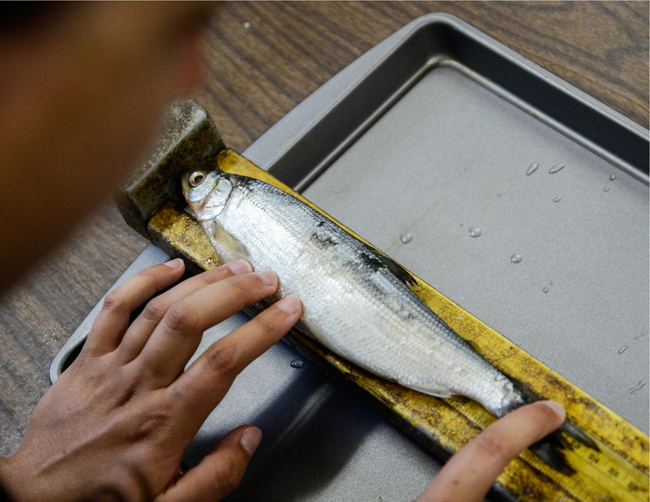
Ellen George works on a cisco, her study species in Lake Ontario. Credit: Heather Ainsworth
— By Chris Gonzales, Freelance Science Writer, New York Sea Grant
Ithaca, NY, February 9, 2020 – Scientists are using genetics to locate the spawning grounds of the cisco, a little-known but key fish in the Lake Ontario food chain. As the New York Sea Grant (NYSG)-funded researchers map this habitat, they hope to support the recovery of not only the little cisco, but also the big trout and salmon.
It is winter on the lake: cloudy skies, a blanket of snow stretching to the horizon. A figure wearing a dark parka is bent over a hole, seeming to lower a three-inch-diameter tube through the hole. No, he is not fishing. This researcher is using a special pump he and his team designed to gently draw out cisco eggs from beneath the nearly three feet of Lake Ontario ice. The team, led by Matthew Hare of Cornell University’s Department of Natural Resources, is going to great lengths so as not to damage the delicate prizes. This work must take place between January and April, a critical time in the eggs’ development.
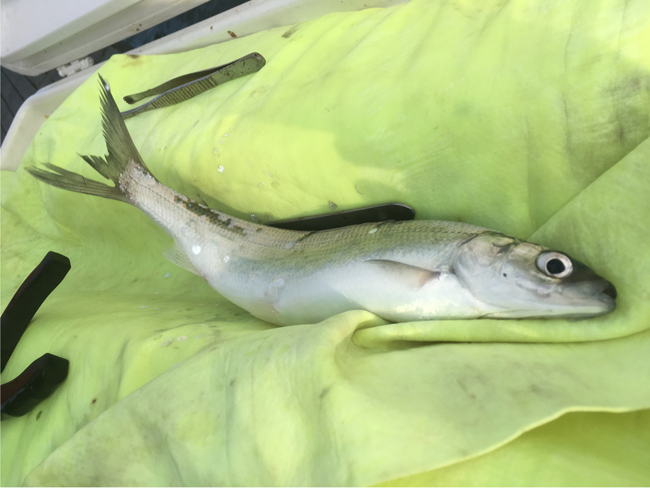
After an adult male cisco is weighed and measured, a fin clip is taken for genetic material before the fish is released unharmed into Chaumont Bay. Credit: Ellen George
Once fully-grown, cisco are a food source for lake trout and Atlantic salmon—two highly desirable fish for sport as well as the dinner table. Cisco experienced declines in the late 1800s and early 1900s, due to overfishing, habitat declines, and competing species from outside. In more recent years, things have only gotten worse.
Real ID
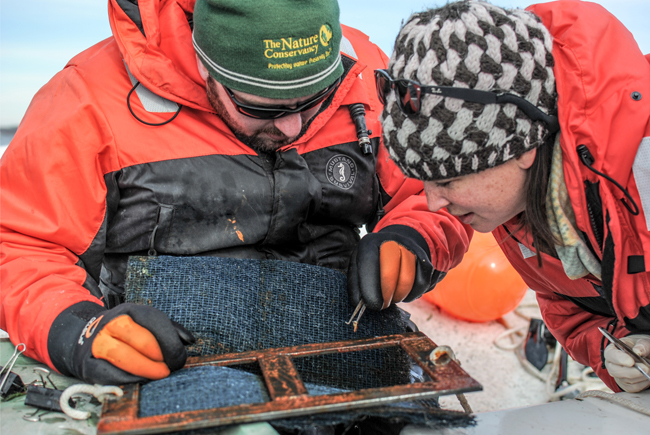
Brian Roat (The Nature Conservancy of New York, left) and Ellen George (Cornell University, right) look for eggs on an egg mat in Sandy Pond, Lake Ontario. Credit: Mat Levine
The scientists are using genetic techniques to confirm the eggs they are finding are indeed the elusive but struggling cisco, which we have now learned spawns in the shallow, rocky shoals of Chaumont Bay, New York—an area known for its outdoor recreation and camping, as well as vacation homes and restaurants.
“What we’re trying to do is build resilience back into the food web by promoting restoration of these native prey fish species,” Ellen George, then a PhD student at Cornell University and a leader of the research, said in Audubon. “To do that, my project is to learn as much as we can about them.”
“Cisco (Coregonus artedi) were once abundant in Lake Ontario and throughout the Great Lakes, supporting important commercial and sport fisheries,” said Jesse Lepak, an ecologist with New York Sea Grant. “Stocks once represented a primary prey fish in Lake Ontario but now they are dramatically depleted and there is need to better understand and potentially restore their populations.”
Big Fish
People around Lake Ontario rely on the region’s fisheries for not only their economic value—reeling in the latest catch is arguably part of the culture. A recent assessment put the value of angling in the area at $114 million (1). Thus the little-known, humble cisco, if its populations could be revived, could bolster the number of the much larger trout and salmon, an outcome the scientists—and the sport and nature lovers who follow them—find interesting.
In late May of 2018, researchers representing a number of organizations held a workshop for stakeholders to exchange ideas, provide updates, and participate in breakout groups focused on the comeback fish in Lake Ontario. Discussions were organized around food web ecology, spawning populations and habitat, early life history, and genetic structure. The group set priorities and made plans for future work and collaborations. This information was included in a workshop summary completed at the end of 2018, which Lepak says will be made available to all participants in late 2019.
The researchers realized they needed to better connect the groups who are studying cisco fish ecology. They also want to work on monitoring, conservation, and management of the populations. Lepak says the workshop “generated synergy among participants and should facilitate our understanding and management of cisco.”
Supported by funds from NYSG and The Nature Conservancy, the partner effort attracted over 30 experts, representing Cornell University, the New York State Department of Environmental Conservation, the Ontario Ministry of Natural Resources and Forestry, Queen’s University, State University of New York Brockport, University of Buffalo, the US Fish and Wildlife Service, and the US Geological Survey. Participants met at the Cornell University Biological Field Station in Bridgeport, New York.
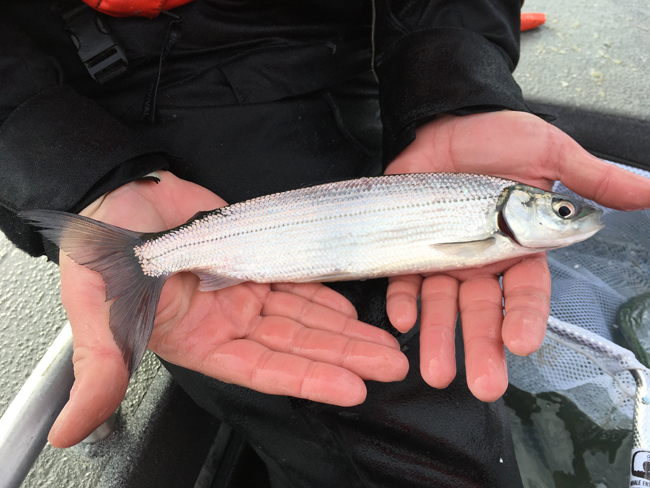
Restoring cisco populations in Lake Ontario is the focus of an international (U.S./Canadian) collaborative effort, as evidenced by "Identifying Research Priorities for Cisco in Lake Ontario," a report issued in late February 2019. Credit: Ellen George
Footnotes
Connelly, N.A. and T.L. Brown. 2009. New York statewide angler survey 2007, Report 1: Angler effort and expenditures. NYS Department of Environmental Conservation, Bureau of Fisheries. 109pp. Accessed August 18, 2019.
References
George, Ellen M.; Stott, Wendylee; Young, Brian P.; Karboski, Curtis T.; Crabtree, Darran L.; Roseman, Edward F.; Rudstam, Lars G. 2017: "Confirmation of cisco spawning in Chaumont Bay, Lake Ontario using an egg pumping device" Journal of Great Lakes Research, vol. 43; page(s) 204-208
In Photos: Researchers Study Cisco
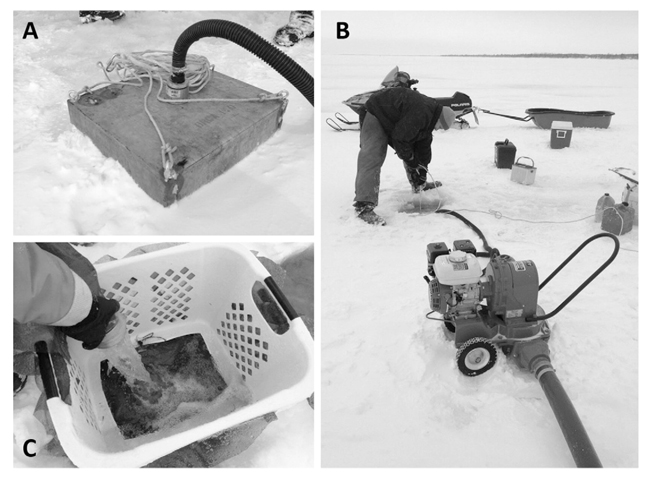
A researcher samples cisco eggs in Chaumont Bay, Lake Ontario, using a diaphragm pump. Credit: Ellen George
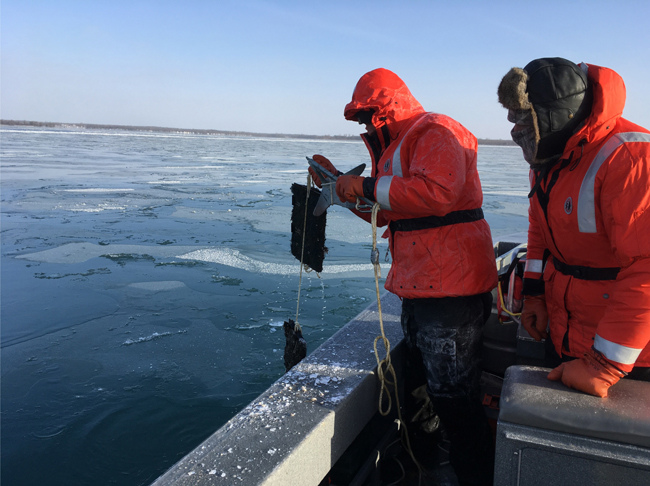
USFWS biologists Eric Bruestle (left) and Curt Karboski (right) retrieve egg mats on a cold (3°F) day near Grenadier Island, Lake Ontario. Credit: Ellen George
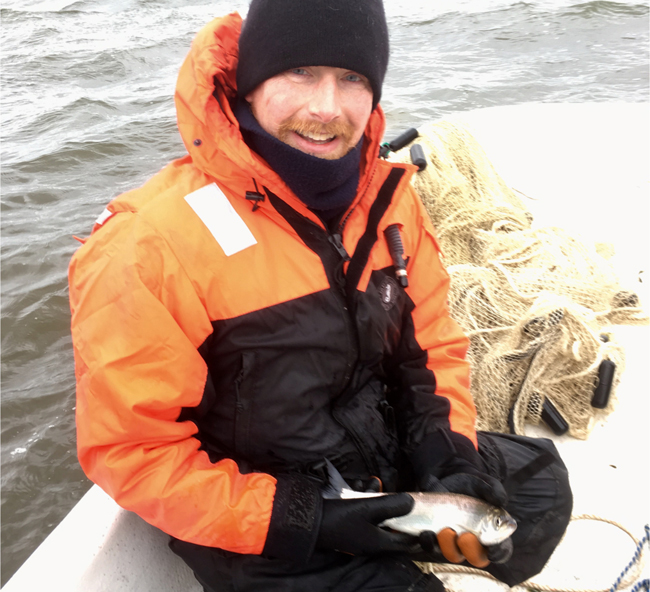
Darran Crabtree (The Nature Conservancy of New York) with male cisco caught in Sandy Pond, Lake Ontario. Credit: Ellen George
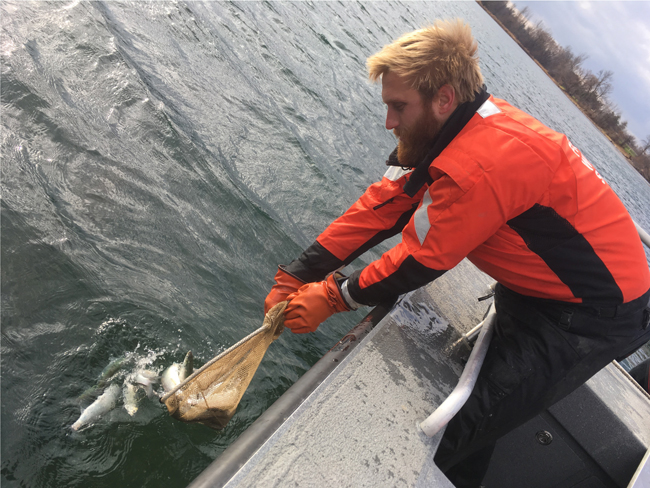
USFWS biologist Curt Karboski releases adult cisco that were captured in trap nets in Chaumont Bay. Credit: Ellen George

Ellen George does field and lab work at the Cornell Biological Field Station at Shackelton Point, N.Y. Credit: Heather Ainsworth
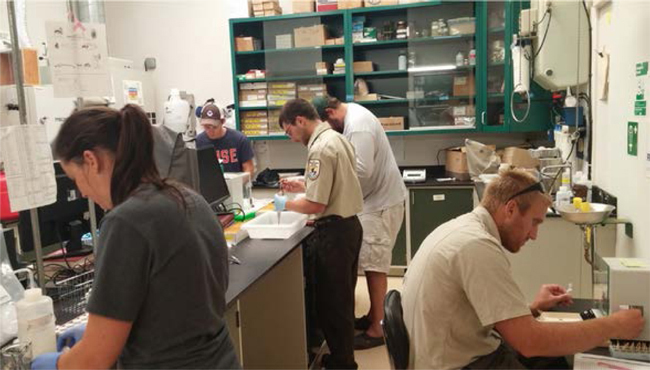
Scientists in the lab take genetic samples from over 300 captured cisco. Credit: Brian Weidel, United States Geological Survey, Lake Ontario Biological Station
More Info: New York Sea Grant
New York Sea Grant (NYSG), a cooperative program of Cornell University
and the State University of New York (SUNY), is one of 34 university-based
programs under the National Oceanic and Atmospheric Administration’s
National Sea Grant College Program.
Since 1971, NYSG has represented a statewide network of integrated
research, education and extension services promoting coastal community
economic vitality, environmental sustainability and citizen awareness
and understanding about the State’s marine and Great Lakes resources.
Through NYSG’s efforts, the combined talents of university scientists
and extension specialists help develop and transfer science-based
information to many coastal user groups—businesses and industries,
federal, state and local government decision-makers and agency managers,
educators, the media and the interested public.
The program maintains Great Lakes offices at Cornell University, SUNY
Buffalo, SUNY Oswego and the Wayne County Cooperative Extension office
in Newark. In the State's marine waters, NYSG has offices at Stony Brook
University in Long Island, Brooklyn College and Cornell Cooperative
Extension in NYC and Kingston in the Hudson Valley.
For updates on Sea Grant activities: www.nyseagrant.org has RSS, Facebook, Twitter, and YouTube links. NYSG offers a free e-list sign up via www.nyseagrant.org/nycoastlines for its flagship publication, NY Coastlines/Currents, which is published quarterly. Our program also produces an occasional e-newsletter,"NOAA Sea Grant's Social Media Review," via its blog, www.nyseagrant.org/blog.